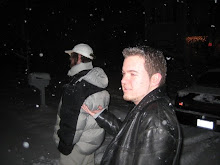Whining aside, I actually read through most of Palestine. Maybe it was the chance to distract myself with something other than paper writing, but I found myself surprisingly drawn in by the book as I continued to read further than the initial chapter or two that I started last week. I'm fascinated by Sacco's method: he's a journalist basically trying to do a story on the hardships that the Palestinian refugees have faced since the formal establishment of the nation of Israel and the arrival and expansion of Jewish settlement in the area. Like any other good journalist, he talks to eye witnesses, conducts and records interviews with all kinds of people, and of course takes photographs. However, rather than turning this multimedia collection of information into a book, or an article, or a TV report, he creates a graphic novel. At some point the question must be asked: why a graphic novel? Part of it could be that any journalist could go to Israel and do the same thing he did, but he's the only one that's going to try to sell his story as a comic.
But surely the graphic novel medium adds something to the story itself. I guess illustrations add something that even photographs can't capture. Creating a graphic novel really allowed the author to both depict the lives of the Palestinian people in a graphic and moving way, and also to tell his own story. I have to wonder how exactly he did most of the illustration. I mean, did he sit there and sketch what he saw while he was there? He doesn't make it sound that way. Did he draw from memory, or did he take pictures as points of reference and reminders? On a certain level, I guess it really doesn't matter how he created the book: the fact remains that it is a composite of his experiences in Israel. Of course he could be taking some artistic liberties and illustrating certain things selectively or suggestively--that's part of the whole point of the book. He's trying to show the world through his eyes what it is like to live as a Palestinian. Like a few of the other graphic novels that we've read, there are times when the action takes a backseat to narration, and there are only a few images that decorate pages of text. These are usually longer stories narrated from the point of view of the interviewee. It seems somehow appropriate that the author doesn't try to over-illustrate other people's stories. The illustrative style in this work is just all over the place: in some sections (like those described above), it's almost like reading a journal with illustrations due to all of the narration; in other sections there are so many little images in sequence that it's practically like a flipbook.


No comments:
Post a Comment